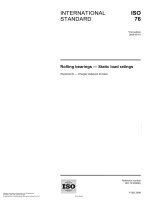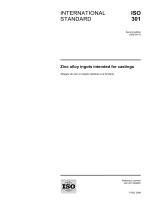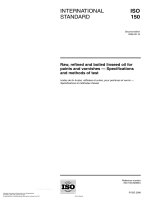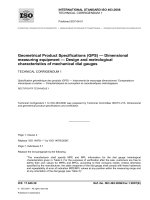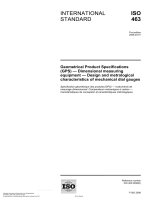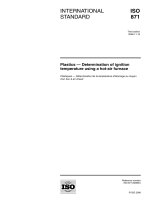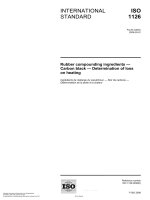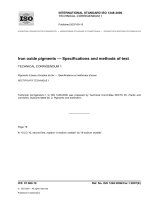Tiêu chuẩn iso 00247 2006
Bạn đang xem bản rút gọn của tài liệu. Xem và tải ngay bản đầy đủ của tài liệu tại đây (176.17 KB, 8 trang )
INTERNATIONAL
STANDARD
ISO
247
Fourth edition
2006-09-15
Rubber — Determination of ash
Caoutchouc — Détermination du taux de cendres
--`,,```,,,,````-`-`,,`,,`,`,,`---
Reference number
ISO 247:2006(E)
Copyright International Organization for Standardization
Provided by IHS under license with ISO
No reproduction or networking permitted without license from IHS
© ISO 2006
Not for Resale
ISO 247:2006(E)
PDF disclaimer
This PDF file may contain embedded typefaces. In accordance with Adobe's licensing policy, this file may be printed or viewed but shall
not be edited unless the typefaces which are embedded are licensed to and installed on the computer performing the editing. In
downloading this file, parties accept therein the responsibility of not infringing Adobe's licensing policy. The ISO Central Secretariat
accepts no liability in this area.
Adobe is a trademark of Adobe Systems Incorporated.
Details of the software products used to create this PDF file can be found in the General Info relative to the file; the PDF-creation
parameters were optimized for printing. Every care has been taken to ensure that the file is suitable for use by ISO member bodies. In the
unlikely event that a problem relating to it is found, please inform the Central Secretariat at the address given below.
--`,,```,,,,````-`-`,,`,,`,`,,`---
© ISO 2006
All rights reserved. Unless otherwise specified, no part of this publication may be reproduced or utilized in any form or by any means,
electronic or mechanical, including photocopying and microfilm, without permission in writing from either ISO at the address below or
ISO's member body in the country of the requester.
ISO copyright office
Case postale 56 • CH-1211 Geneva 20
Tel. + 41 22 749 01 11
Fax + 41 22 749 09 47
Web www.iso.org
Published in Switzerland
ii
Copyright International Organization for Standardization
Provided by IHS under license with ISO
No reproduction or networking permitted without license from IHS
© ISO 2006 – All rights reserved
Not for Resale
ISO 247:2006(E)
Foreword
ISO (the International Organization for Standardization) is a worldwide federation of national standards bodies
(ISO member bodies). The work of preparing International Standards is normally carried out through ISO
technical committees. Each member body interested in a subject for which a technical committee has been
established has the right to be represented on that committee. International organizations, governmental and
non-governmental, in liaison with ISO, also take part in the work. ISO collaborates closely with the International
Electrotechnical Commission (IEC) on all matters of electrotechnical standardization.
International Standards are drafted in accordance with the rules given in the ISO/IEC Directives, Part 2.
The main task of technical committees is to prepare International Standards. Draft International Standards
adopted by the technical committees are circulated to the member bodies for voting. Publication as an
International Standard requires approval by at least 75 % of the member bodies casting a vote.
Attention is drawn to the possibility that some of the elements of this document may be the subject of patent
rights. ISO shall not be held responsible for identifying any or all such patent rights.
ISO 247 was prepared by Technical Committee ISO/TC 45, Rubber and rubber products, Subcommittee SC 2,
Testing and analysis.
--`,,```,,,,````-`-`,,`,,`,`,,`---
This fourth edition cancels and replaces the third edition (ISO 247:1990), which has been revised to update the
normative references.
© ISO for
2006
– All rights reserved
Copyright International Organization
Standardization
Provided by IHS under license with ISO
No reproduction or networking permitted without license from IHS
iii
Not for Resale
.
--`,,```,,,,````-`-`,,`,,`,`,,`---
iv
Copyright International Organization for Standardization
Provided by IHS under license with ISO
No reproduction or networking permitted without license from IHS
Not for Resale
INTERNATIONAL STANDARD
ISO 247:2006(E)
Rubber — Determination of ash
1 Scope
This International Standard specifies two methods for the determination of ash from raw rubbers, compounded
rubbers and vulcanizates. The methods are applicable to raw, compounded or vulcanized rubbers of the M, N,
O, R and U families described in ISO 1629, except that:
— Method A shall not be used for the determination of ash from compounded or vulcanized rubbers containing
chlorine, bromine or iodine.
— Method B shall be used for compounded or vulcanized rubbers containing chlorine, bromine or iodine. lt
shall not be used for uncompounded rubbers.
— Lithium and fluorine compounds may react with silica crucibles to form volatile compounds, giving low ash
results. Platinum crucibles shall therefore be used for ashing fluorine-containing and Iithium-polymerized
rubbers.
This International Standard does not cover the interpretation of the ash results as to the inorganic chemical
content of a compound or vulcanizate. This is the responsibility of the analyst, who has to be aware of the
behaviour of rubber additives at elevated temperatures.
The two methods of ashing do not give identical results in all cases, and it is necessary to state in the test report
the method of ashing employed.
2 Normative references
The following referenced documents are indispensable for the application of this document. For dated
references, only the edition cited applies. For undated references, the latest edition of the referenced document
(including any amendments) applies.
ISO 248, Rubber, raw — Determination of volatile-matter content
--`,,```,,,,````-`-`,,`,,`,`,,`---
ISO 1629, Rubber and latices — Nomenclature
ISO 1795, Rubber, raw natural and raw synthetic — Sampling and further preparative procedures
3 Principle
3.1 Method A
A weighed test portion is heated in a crucible over a gas burner. After expulsion of the volatile decomposition
products, the crucible is transferred to a muffle furnace where it is heated until all the carbonaceous matter has
been burnt off and constant mass is attained.
3.2 Method B
A weighed test portion is heated in a crucible in the presence of sulfuric acid, first by means of a gas burner and
then in a muffle furnace until all the carbonaceous matter has been burnt off and constant mass is attained.
© ISO for
2006
– All rights reserved
Copyright International Organization
Standardization
Provided by IHS under license with ISO
No reproduction or networking permitted without license from IHS
1
Not for Resale
ISO 247:2006(E)
4 Reagent
4.1 Sulfuric acid (for method B only), analytical grade, ρ = 1,84 g/cm3 .
5 Apparatus
Ordinary laboratory apparatus, plus the following:
5.1 Crucible, of porcelain, silica or platinum, of capacity approximately 50 cm3 . For raw synthetic rubbers, it is
permitted to use a crucible of minimum capacity 25 cm3 per gram of test portion.
5.2 Heat-resistant, thermally insulating board, 100 mm square and of thickness approximately 5 mm, with
a central hole to accommodate the crucible (5.1). About two-thirds of the crucible shall project below the board.
5.3 Bunsen burner, or similar type of gas burner.
5.4 Muffle furnace, fitted with a flue and with provision for controlling the air flow through the furnace. (This
may be achieved by adjusting the door opening.) A temperature-controlling device is required to maintain a
temperature of 550 ◦ C ± 25 ◦ C or 950 ◦ C ± 25 ◦ C.
6 Preparation of the test portion
6.1 Test portions of raw natural rubber shall be cut from the homogenized piece prepared in accordance with
ISO 1795. Test portions of raw synthetic rubbers shall be cut from the dried rubber obtained after carrying out
the determination of volatile-matter content in accordance with ISO 248.
6.2 Test portions of rubber compounds shall be comminuted by hand.
6.3 Test portions of vulcanizate shall be sheeted or crumbed on a mill or comminuted by hand.
6.4 Care shall be taken to ensure that test portions of rubber compounds and vuIcanizates are representative
of the sample.
7 Procedure
Heat a clean empty crucible (5.1) of appropriate size for about 30 min in the muffle furnace (5.4), maintained at
550 ◦ C ± 25 ◦ C, allow to cool to ambient temperature in a desiccator and weigh to the nearest 0,1 mg. Take a
test portion of about 5 g of raw rubber or 1 g to 5 g of compounded rubber or vulcanizate, according to the mass
of ash to be expected, and weigh to the nearest 0,1 mg. Place the weighed test portion in the crucible mounted
in the hole in the heat-resistant, thermally insulating board (5.2). Heat the crucible gently with the burner (5.3) in
a hood for proper ventilation, taking care that the rubber does not ignite. If any material is lost due to spurting or
frothing, repeat the above procedure with a new test portion.
When the rubber has decomposed to a charred mass, gradually increase the heat from the burner until the
volatile decomposition products have been substantially expelled and a dry carbonaceous residue remains.
Transfer the crucible and its contents to the muffle furnace, maintained at 550 ◦ C ± 25 ◦ C (see, however, the
Note), leaving the door of the furnace slightly open to provide sufficient air to oxidize the carbon.
Continue heating until the carbon is completely oxidized and a clean ash is obtained. Remove the crucible and
its contents from the furnace, allow to cool to ambient temperature in the desiccator and weigh to the nearest
0,1 mg. Then heat the crucible and its contents again for about 30 min in the muffle furnace, maintained at
550 ◦ C ± 25 ◦ C (or 950 ◦ C ± 25 ◦ C — see the Note), allow to cool to ambient temperature in the desiccator
and re-weigh to the nearest 0,1 mg. This mass shall not differ from the previous mass by more than 1 mg in the
case of raw rubbers or by more than 1 % relative to the amount of ash for compounds and vulcanizates. If this
2
Copyright International Organization for Standardization
Provided by IHS under license with ISO
No reproduction or networking permitted without license from IHS
© ISO 2006 – All rights reserved
Not for Resale
--`,,```,,,,````-`-`,,`,,`,`,,`---
7.1 Method A
ISO 247:2006(E)
requirement is not fulfilled, repeat the heating, cooling and weighing procedure until the difference between two
successive weighings meets this requirement.
NOTE For compounds and vulcanizates, a temperature of 950 ◦ C ± 25 ◦ C may be used.
7.2 Method B
Heat a clean empty crucible (5.1) of appropriate size for about 30 min in the muffle furnace (5.4), maintained at
950 ◦ C ± 25 ◦ C, allow to cool to ambient temperature in a desiccator and weigh to the nearest 0,1 mg. Take a
test portion of about 1 g to 5 g of the compound or vulcanizate and weigh to the nearest 0,1 mg. Place the test
portion in the crucible and pour about 3,5 cm3 of concentrated sulfuric acid (4.1) over it so that the rubber is
completely wetted. Place the crucible and its contents in the hole in the heat-resistant, thermally insulating
board (5.2) and heat gently with the burner in a hood for proper ventilation. If, during the initial reaction, the
mixture swells excessively, withdraw the flame to avoid possible loss of material.
When the reaction becomes more gentle, increase the heat from the burner until the excess sulfuric acid is
volatilized and a dry, carbonaceous residue remains. Transfer the crucible and its contents to the muffle furnace,
maintained at 950 ◦ C ± 25 ◦ C, and heat for about 1 h until all the carbon is completely oxidized and a clean ash
is obtained. Remove the crucible and its contents from the furnace, allow to cool to ambient temperature in a
desiccator and weigh to the nearest 0,1 mg. Then heat the crucible and its contents again for about 30 min in
the muffle furnace, maintained at 950 ◦ C ± 25 ◦ C, allow to cool to ambient temperature in the desiccator and
re-weigh to the nearest 0,1 mg.
If this mass differs from the previous mass by more than 1 % relative to the amount of ash, repeat the heating,
cooling and weighing procedure until the difference between two successive weighings is less than 1 % relative
to the amount of ash.
8 Expression of results
The ash content is given, as a percentage by mass, by the formula
m2 − m1
× 100
m0
where
m0
is the mass, in grams, of the test portion;
m1
is the mass, in grams, of the empty crucible;
m2
is the mass, in grams, of the crucible and ash.
9 Test report
The test report shall include the following particulars:
a) all details required for full identification of the piece or sample tested;
b) a reference to this International Standard;
c) the method employed — method A or method B;
d) the temperature used, and the reason for its choice if 950 ◦ C was used for method A;
e) the ash determined for the product tested, as a percentage by mass;
f)
the date of the test.
--`,,```,,,,````-`-`,,`,,`,`,,`---
© ISO for
2006
– All rights reserved
Copyright International Organization
Standardization
Provided by IHS under license with ISO
No reproduction or networking permitted without license from IHS
3
Not for Resale
ISO 247:2006(E)
--`,,```,,,,````-`-`,,`,,`,`,,`---
ICS 83.060
Price based on 3 pages
© ISO 2006
Copyright International
Organization
Standardization
– Allforrights
reserved
Provided by IHS under license with ISO
No reproduction or networking permitted without license from IHS
Not for Resale
